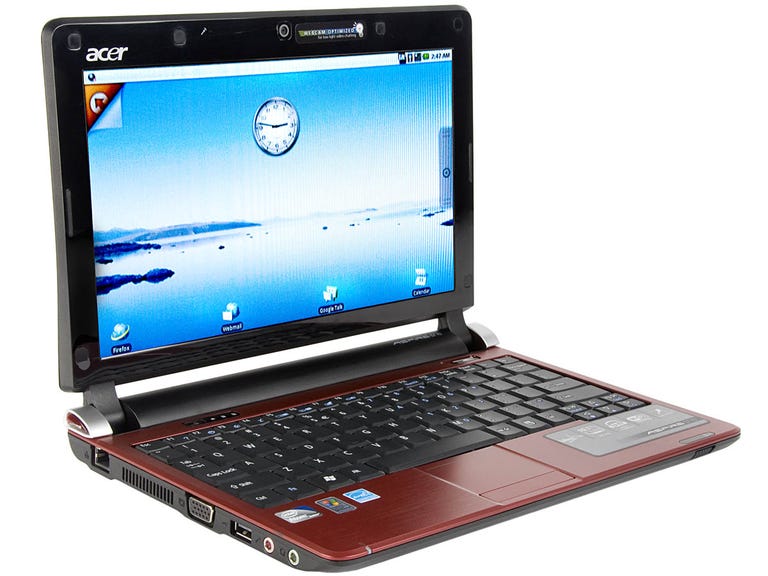 Why You Can Trust CNET
Why You Can Trust CNET Acer Aspire One D250 Android review: Acer Aspire One D250 Android
The 10.1-inch Aspire One D250 Android is a netbook with a difference. It not only has Windows XP installed but also Android, which allows you to quickly boot the system for access to rudimentary apps, such as a Web browser. Its battery life is good, and it's an attractive machine too
The latest version of the 10.1-inch Acer Aspire One D250 is a netbook with a difference. It's the first mini PC we've seen that comes not only with Windows XP installed but also with Google Android, an operating system designed primarily for mobile phones. Despite its twin-OS configuration, this miniature marvel retails for a relatively reasonable £250. Note that we reviewed the XP-only version of this machine in June.
The Good
The Bad
The Bottom Line
Robots are the future
Some people may wonder why Acer has bothered supplying Android on a netbook, but the answer becomes clear within about 17 seconds of hitting the power button. The OS boots about three times faster than XP, which means you can be on the Internet, check your emails and have grown bored of watching people fall over on YouTube before XP's hourglass has vanished.
Don't expect access to many applications, though. You get Minefield (a development version of the Firefox browser), plus webmail, Google Talk and Calendar. More applications can be found by clicking the settings tab on the right side of the Android desktop, but most of them are pretty lame. There's an alarm clock, generic Android browser, calculator, calendar, camera, contacts list and music player -- the sorts of things you'd get on a mobile phone, basically.
Danger, Will Robinson
As attractive as the presence of Android may seem, it's also fraught with problems. The biggest of them is the fact it was designed for mobiles, not PCs. Firstly, you'll need to remind yourself that the D250 doesn't have a touchscreen, despite the fact it's using an operating system designed for gadgets with such an interface. Then you'll need to get used to the odd graphical user interface, which is impossible to control using a mouse alone -- you'll need to keep the Esc key handy for going back a step each time you're done with a new menu.

We can sort of forgive the interface, but we can't excuse the fact that you're unable to add any new applications to Android on this device. Unlike Android mobile phones, the D250 doesn't have access to the Android Market for new applications, and, therefore, can't be upgraded in the same manner. If you want to enjoy new applications or do anything other than mess about on the Internet, you'll need to fire up XP.
Come back, Windows, all is forgiven
Annoyingly, it's not possible to boot straight into XP -- you'll need to hit the power button, wait for Android to boot, and then click a shortcut at the top left of the Android desktop to initiate XP mode. As a result, the D250 shoots itself in the foot, taking a few seconds longer to boot to what we believe is a truly usable state than most other netbooks do.
Once XP's loaded, you'll be able to check your email and watch YouTube clips to your heart's content, as well as do incredible things like download new software or use multiple applications simultaneously (no, Android isn't any good at multitasking). Seriously, once you've entered XP mode, it's like being in the future or something.
Business as usual
The D250, despite the inclusion of Android, is pretty ordinary to look at. The red finish (glossy on the lid and matte on the inside) is pretty unusual, but the 10.1-inch, 1,024x768-pixel screen, Intel Atom N270 CPU, 1GB of RAM, and 160GB of storage are all par for the netbook course. As a result, the D250's performance is like that of pretty much every other netbook in its class. Battery life is above average, however, thanks to a large, six-cell battery. In Battery Eater's intensive Classic test, the D250 lasted for 6 hours and 21 minutes while running XP.
Conclusion
The Acer Aspire One D250 Android is a pretty decent netbook, but we're not sure its Android OS contributes very much. It'll let you surf the Web quickly, but, if you fancy doing anything else, you'll need to fire up Windows XP. After a while, you'll begin to question whether it was worth bothering with the Android OS in the first place. Ultimately, we think its inclusion is something of a gimmick, but, as the D250 isn't a bad device, it's one we can ultimately forgive.
Edited by Charles Kloet
